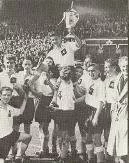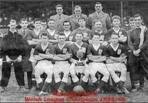
Great English Strikers
The list of great English strikers is a long one; Shearer. Linaker, Charlton, Lofthouse etc., many more names have been lost in the mists of time but the lineage of great English strikers began with two free-scoring nineteenth century amateurs; friends, team-mates and complete opposites – G.O. Smith and W.N. Gobbold.
Gilbert Oswald Smith (1872-1943) was an amateur player who learned his trade at Charterhouse School before representing Oxford University.
He played his club football for Corinthians, probably the top amateur club of the day and a side easily comparable with the best professional teams. Smith also captained England in 13 of his 20 appearances scoring 11 goals.
For Corinthians he was prolific scoring 113 goals in 131 games; a record which earned him the title of ‘the first great English centre-forward.’
What made Smith’s success so notable was that, in what was a very rough and physical game, he was unlike the average footballer being described as “slight of build and a chronic asthmatic.”
His goalscoring record may have even been better but for his complete refusal to head the ball. He believed the practice should be banned but he had a thunderous shot and pin-point accuracy when both shooting and passing.
His finest game was probably against Ireland in 1899. Smith scored four goals, including a five minute hat-trick, in England’s 13-2 victory.
If Smith was slightly built the opposite was true of another of the great English strikers and his predecessor in the England team William Neville ‘Nuts’ Cobbold (1862-1922).
As an inside-forward he was built for “heard, strenuous play.” Nuts was described by his friend G.O. Smith as “first among all the forwards I have known.”
Cobbold’s nickname came about, according to C.B. Fry because, “He was the very best Kentish cob quality, all kernel and extremely hard to crack.”
Blessed with blistering pace and dazzling dribbling skills Cobbold’s career closely resembled Smith’s; Charterhouse, University (Cambridge not Oxford), Corinthians and England. Cobbold played nine times for England scoring twice on his international debut against Ireland in 1883.
Like Smith Cobbold resolutely refused to head the ball but, unlike his younger colleague, Nuts wasn’t overly concerned with the passing element of the game preferring instead to rely on his dribbling skills.
Contemporary observers wrote “When Cobbold gets possession of the ball he seemed to keep it clued to his toe, darting hither and thither as he pursued a tortuous course towards goal.” Cobbold was famed for his lethal shooting ability and it was said that he would “send the ball in like a charge from a hundred-ton gun.”
Friends, but very different in style and appearance, Smith and Cobbold were both prolific goal-scorers and idolised by the nations football fans as two great English strikers from the Victorian era.
|
|
|
Copyright NonLeague Football History 2008
 Delicious
Delicious  Digg
Digg  Facebook
Facebook  Google Bookmarks
Google Bookmarks  Furl
Furl  Stumbleupon
Stumbleupon  Yahoo My Web
Yahoo My Web



